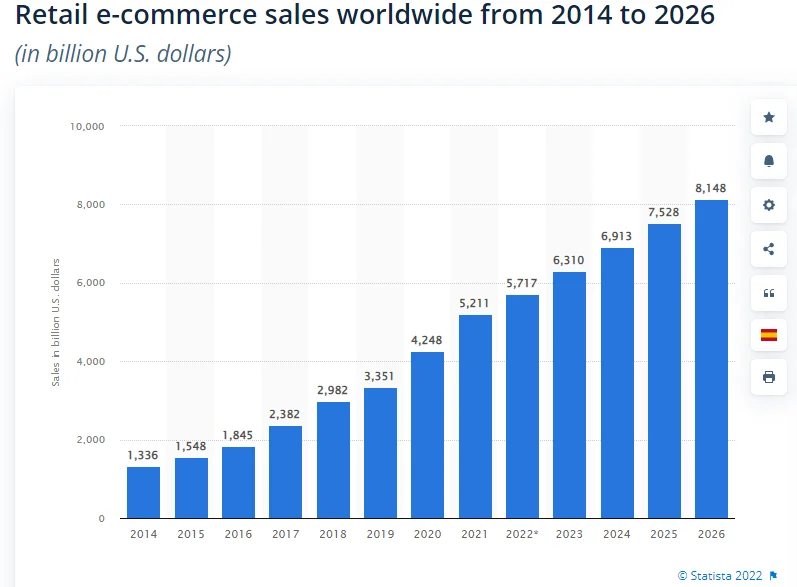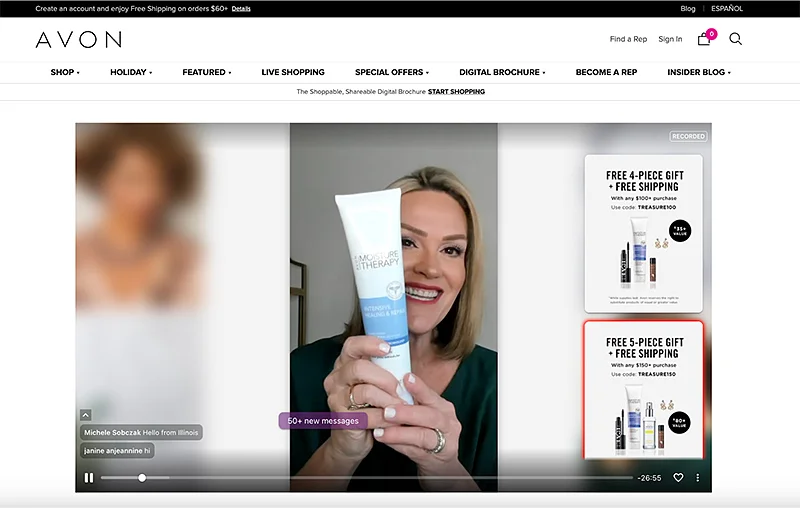As e-commerce sales are expected to grow, more customers will shop online, which means businesses can sell more and earn more.
The global e-commerce market is expected to reach $6.3 trillion in 2023, and the U.S. e-commerce market will reach over $1.1 trillion in sales. By 2026, the e-commerce market is expected to exceed $8.1 trillion.

This is great news for ecommerce businesses looking to boost their sales.
Thanks to ecommerce software platforms like Vimmi and marketplaces such as Amazon, Walmart, anyone can start an online shop without any technical expertise.
We won’t sugarcoat this, starting an ecommerce business can be exciting, but running and sustaining an ecommerce is anything but easy.
Did you know that approximately 90% of e-commerce businesses fail in the first four months?
The reason why we’re telling you this is not to intimidate you but to make you aware, equip you with knowledge so that you avoid the common mistakes causing ecommerce failures and cut it to the 10% of successful businesses.
Common Reasons for Ecommerce Failures and Their Solutions
The most effective approach to understanding the causes of e-commerce failures is to examine them both from a business perspective and consider the pain points experienced by customers.
Here are some of the most common reasons why an ecommerce fails:
Lack of Market Research
Knowing who your customers are, what they desire, and how they behave online is foundational. Without this understanding, you’re essentially navigating a vast ocean without a compass.
The target market is a diverse landscape of preferences, behaviors, and expectations that must be meticulously charted.
E-commerce success hinges on delivering products that fulfill a genuine need within the market. Without a comprehensive understanding of customer pain points and desires, your offerings may miss the mark.
Solution:
Comprehensive Market Research:
Invest time and resources in thorough market research. This involves analyzing your target demographic, understanding their preferences, behaviors, and pain points. Identify your competitors and scrutinize their strategies. Utilize tools, surveys, and analytics to gather quantitative and qualitative data.
Competitor Analysis:
Regularly assess the competitive landscape. Understand what works well for your competitors, what doesn’t, and identify gaps in the market. Analyzing their marketing strategies, pricing models, and customer engagement can provide valuable insights for refining your own approach.
Customer Feedback Mechanisms:
Establish direct channels for customer feedback. This can include surveys, reviews, and social media interactions. Actively listen to your customers, respond to their concerns, and use their feedback to iterate and enhance your offerings.
Stay Current:
Markets evolve, and staying stagnant is a recipe for obsolescence. Regularly update your market research to adapt to shifting trends, emerging technologies, and evolving consumer preferences.
Inadequate Business Planning
Inadequate business planning often results in a lack of clear direction and strategy. Without a roadmap, the business may struggle to navigate the dynamic e-commerce landscape, making it susceptible to market shifts and competitive pressures.
Solution:
Strategic Business Plan Development:
Develop a detailed business plan that outlines clear objectives, strategies, and tactics. This plan should encompass marketing strategies, financial projections, and a roadmap for growth, providing a comprehensive guide for the business’s trajectory.
Cross-Functional Collaboration:
Foster collaboration between different departments within the business. A well-structured business plan should encourage cross-functional coordination, ensuring that marketing, finance, operations, and other facets work cohesively towards common objectives.
Clear KPIs:
Define and track key performance indicators aligned with the objectives outlined in the business plan. This provides measurable benchmarks for success and facilitates ongoing assessment and improvement.
Stakeholder Communication Strategy:
Develop a clear communication strategy for stakeholders, including employees, investors, and partners. Transparency about business objectives and
Poor Product Content and E-commerce Failure
Ecommerce success relies heavily on the quality of product content. Insufficient product descriptions can be a critical stumbling block for e-commerce success. If your product descriptions are lackluster, generic, or fail to highlight the unique selling points, you risk losing the interest of potential customers.
Similarly, if your product listings lack high-quality images or, worse, have none at all, customers are left in the dark.
Insufficient product information and poor-quality visuals can potentially lower the perceived value of your products leading to hesitancy and cart abandonment.
Solution:
Compelling Product Descriptions:
Invest time and effort in crafting compelling, detailed product descriptions. Clearly communicate the features, benefits, and unique selling propositions of each product. Address potential customer questions preemptively to reduce uncertainties.
High-Quality Visuals:
Prioritize high-resolution images that showcase your products from multiple angles. Invest in professional photography to highlight details, textures, and colors accurately. Visuals are the first impression; make it count.
Incorporate Product Videos:
Leverage the power of video content. Create concise, engaging product videos that showcase the product in use, demonstrate its features, and provide a sense of scale. This not only enhances the customer’s understanding but also adds a dynamic element to your product listings.
User-Generated Content:
Encourage your customers to share their experiences through reviews, images, and videos. User-generated content adds authenticity to your product pages and builds trust among potential buyers.
Interactive Elements:
Implement interactive elements such as 360-degree product views or virtual try-ons. This allows customers to virtually examine the product, enhancing their online shopping experience and reducing uncertainty.
Complicated Checkout Processes
Complicated checkout is one of the primary reasons for e-commerce failure.
If your customers encounter a labyrinth of steps, form fields, and confusing navigation, they’re likely to abandon their carts in frustration.
A complicated checkout acts as a barrier, preventing potential buyers from completing their transactions.
When customers face unnecessary hurdles, such as mandatory account creation or a multitude of steps, they are more inclined to abandon their carts and seek simpler alternatives elsewhere.
Solution:
Shoppable Videos on Social Media:
Leverage the power of social media platforms by integrating shoppable videos. These interactive videos enable users to browse and purchase products seamlessly within the same platform. This not only enhances user engagement but also streamlines the purchasing journey.
Guest Checkouts for Simplified Transactions:
Introduce a guest checkout option to simplify the process. Allowing customers to make purchases without the hassle of creating an account reduces friction and caters to those who prefer a quick, one-time transaction.
Friction-Free Checkout Process:
Minimize the number of steps required to complete a purchase. Each additional form field or confirmation step increases the likelihood of cart abandonment, so streamline the process for a seamless customer journey.
Mobile-Optimized Checkout:
With the increasing prevalence of mobile shopping, ensure that your checkout process is optimized for mobile devices. A responsive design and intuitive interface on smartphones and tablets contribute to a smoother transaction process.
Clear CTAs:
Use clear and concise calls-to-action throughout the checkout process. Clearly guide customers on the next steps, reducing any confusion and creating a straightforward path from product selection to completion of the purchase.
Unprofessional, slow, difficult-to-navigate websites
An unattractive website design can deter visitors and create a negative perception of the brand, impacting its overall image. Users often associate the visual appeal of a website with the credibility and professionalism of the business, influencing their trust and willingness to engage.
Complicated navigation and a cluttered user interface contribute to a frustrating user experience. A confusing UI can lead to higher bounce rates as users struggle to find what they need. This not only impedes user satisfaction but also results in decreased conversion rates as potential customers abandon the site before completing desired actions.
Solution:
Website Design:
Choose the right template for your ecommerce that is not only visually appealing but also aligns with the brand’s identity. If you’re working with a developer, find one that understands your requirements and builds a website that resonates with your brand.
Responsivenes:
Ensure the online store has a responsive and user-friendly design. A seamless browsing experience on both desktop and mobile devices is fundamental to retaining visitors and encouraging repeat visits.
Simplified Navigation:
Streamline the website’s navigation, ensuring that users can easily find products and information. Intuitive navigation reduces user frustration, encourages exploration, and ultimately improves the chances of converting visitors into customers.
Poor customer experience
No business can survive with their customers. Whether B2B or B2C, irrespective of the type of ecommerce you operate, providing the best customer experience and support is essential.
When customers face challenges or receive inadequate support, they are more likely to seek alternatives, abandoning the e-commerce platform. They’re also inclined to share their grievances through online portals, leaving negative reviews and social media, tarnishing the brand’s reputation and dissuading potential customers from ordering on your website.
Solutions:
Prompt Customer Support:
Implement a system for timely responses to customer inquiries through various channels, including live chat, email, and social media. Swift and effective support demonstrates commitment to customer satisfaction.
Effective Issue Resolution:
Establish a robust system for handling customer complaints and issues, ensuring that problems are addressed promptly and satisfactory resolutions are provided. Proactive resolution enhances the brand’s reputation.
Consistent and Personalized Communication:
Engage in consistent and personalized communication with customers. Utilize email marketing to provide updates, promotions, and personalized recommendations based on customer preferences.
Collect and Act on Customer Feedback:
Regularly collect feedback from customers and use it to improve processes. Act on constructive criticism to show a commitment to continuous improvement.
Ineffective Marketing and Advertising
Marketing serves as the gateway to attracting potential customers to an online store. Effective marketing is crucial for setting a brand apart from its competitors.
When marketing efforts fall short, the unique value proposition of the e-commerce store may not be communicated effectively, leading to a lack of differentiation and potentially losing customers to competitors.
Without a consistent flow of relevant and valuable content on all across online platforms, ecommerce brands fail to establish themselves as an authority in its industry, potentially losing credibility and customer trust.
Solutions:
Social Media Engagement:
Create engaging content and actively engage with your audience. Platforms like Instagram, Facebook, and Twitter can be powerful tools to build brand awareness and foster a loyal customer base.
Email Marketing Campaigns:
A well-executed email marketing campaign can nurture customer relationships, provide valuable content directly to the inbox, and drive engagement complementing other marketing efforts and building a broader online presence.
Craft personalized and compelling campaigns, share exclusive promotions, and keep customers informed about new products and updates.
Influencer Collaborations:
Partner with influencers in your industry or niche. Influencer collaborations can introduce your brand to a broader audience, leveraging the trust that influencers have built with their followers to drive traffic and sales to your ecommerce store.
Diversified Advertising Avenues:
Strategy: Explore a variety of advertising avenues, both online and offline. This may include paid search advertising, display ads, and even traditional channels such as print media or TV. Diversifying your advertising approach ensures a broader reach.
Consistent Brand Messaging:
Maintain a cohesive and consistent brand message across all channels. Whether online or offline, your marketing efforts should reflect the unique value proposition of your brand, creating a memorable and recognizable identity.
Online Reviews and Testimonials:
Encourage and showcase positive customer reviews and testimonials. Positive online feedback builds trust and credibility, influencing potential customers in their purchasing decisions.
Not Incorporating Video Marketing
Video marketing has emerged as a powerful tool for online engagement. The lack of video content in an ecommerce strategy can result in missed opportunities for customer connection, enhance the overall customer experience, build brand identity, and stay competitive.
As consumers increasingly expect more dynamic and interactive content, the absence of video may result in a diminishing appeal of the e-commerce platform, leading to reduced customer retention and potentially contributing to business failure.
Solutions:
Create Engaging Product Videos:
Develop high-quality and engaging product videos that highlight features, demonstrate use cases, and evoke a connection with the audience. Videos provide a dynamic and immersive experience, enhancing customer understanding and trust.
Live Video Streaming:
Embrace live video streaming for product launches, behind-the-scenes glimpses, and interactive sessions with customers. Live videos foster real-time engagement, allowing businesses to connect with their audience on a personal level.
Another benefit of live streaming is, you can continue to reap the benefits of the recorded sessions even after the live sessions allowing future viewers to watch the recorded videos and buy from the embedded links.
Here’s an example of how Avon uses live streaming on their website to engage with shoppers:

Video Content Across Platforms:
Share video content not only on the online store but also across social media platforms. Video snippets, tutorials, and engaging content can be repurposed to reach a wider audience and drive traffic back to the e-commerce site.
As we explored the common pitfalls that lead to the failure of online businesses, it becomes evident that awareness and proactive measures are the keys to overcoming these hurdles.
